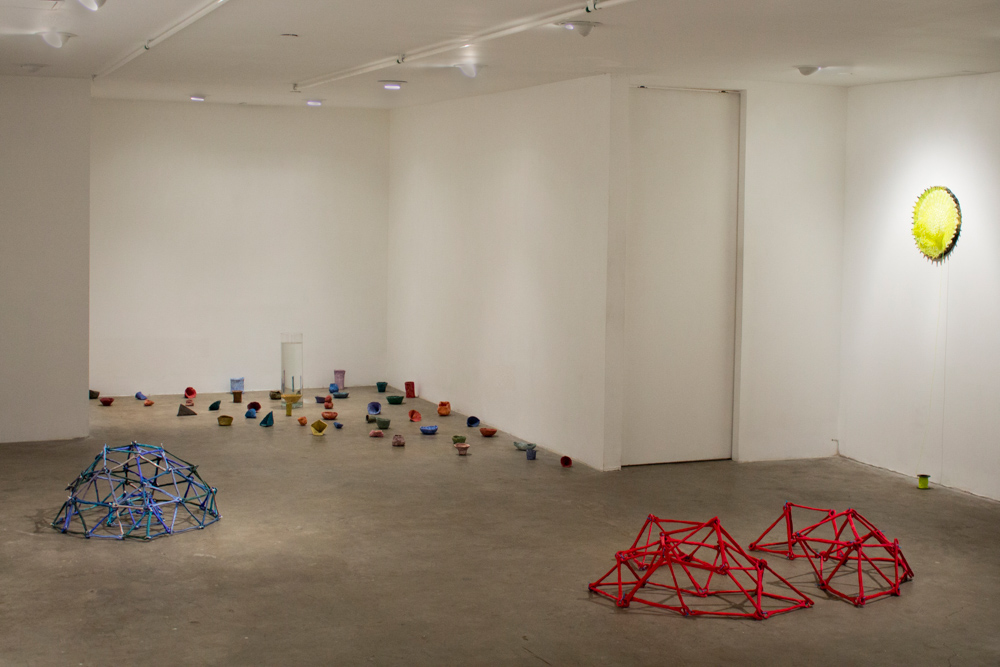
It's Been Hours (solo show), installation view, 2012, Scaramouche, New York
“From intuition one can pass to analysis, but not from analysis to intuition.” – Henri Bergson, An Introduction to Metaphysics
Scaramouche is pleased to present “It’s Been Hours,” the first New York solo exhibition of artist Leah Wolff. The exhibition, which includes pieces from two recent groups of sculptures, Clocks and Impossible Shapes, is meant to advocate for new alternatives to our currently singular method of investigation. Clocks promote an intuitive understanding of time, by measuring it according to the observer’s subjective experience. When looking at Wolff’s Impossible Shapes, our mind fluctuates between what we perceive and what we know to be true. The process and product of her practice explore the cognitive boundaries of our human experience.
Utilizing methods that are chiefly recognized as handmade, Wolff’s compositions are governed by the tension between their imprecision and the accuracy of a scientific model. In Modular Domes I, fired clay pieces are joined together in an arrangement reminiscent of a molecular structure. Her sculptures serve as demonstrative devices that encourage a better understanding of space and structure through the physicality of the object. In their finished form, they become an advocate for separate modes of personal discovery.
Positivism asserts that observational evidence is indispensable to forming our knowledge of the world, and that all things are ultimately measurable. In contrast, according to Heisenberg’s Uncertainty Principle, it is impossible to measure an electron’s position and momentum simultaneously. Electrons exist in a superposition, meaning that they partially occupy all of their theoretical states at the same time, so attempting to locate their exact position via observation suggests a fundamental misunderstanding of their quality. In this way, the modern scientific method has led us to a standstill.
The universe has been proven to be on the micro level immeasurable, and on the macro level far too vast to be knowable. Furthermore, it is only a small privileged class of scientists who have access to the approved technology needed to pursue these endeavors. Therefore, modern-day science becomes the institutional gatekeeper between us and the search for higher meaning, thus leading the individual to a space of intellectual disconnect from their surroundings.
This problem can similarly be applied to the understanding of time, which Henri Bergson discusses in Creative Evolution. Time’s measurement is at odds with its nature, which is always relative to the position and speed of the observer. Furthermore, measuring time (in seconds, minutes etc.) does a disservice to how we intuitively understand its duration, which is always relative to the consciousness that experiences it. In An Introduction to Metaphysics, Bergson distinguishes between two contrasting modes of knowing: relative and absolute. He promotes the absolute knowledge, defining it as an understanding gained only through experience.
In her wall reliefs, Wolff renders impossible shapes onto ceramic slabs. Although they are read as representations of 3-dimensional objects, upon further inspection one notes that it is not geometrically possible for such an object to exist in real life. This causes a fluctuation between intuition and logic: when looking at an Impossible Shape, our mind is forced to occupy the superposition of both states. Wolff posits that experiencing this mindset can lead the viewer to a higher understanding of what it means to occupy a superposition.
As Wolff continues to play with the fundamental elements of scientific theory by utilizing intuitive methods of problem solving, her practice functions as a new method of research where meaning is gathered through making.

Units of Measurement, 2012, Clay, glass cylinder filled with water, Dimensions vary

Modular Domes I, 2012, Clay, glaze and plastic, 17 x 38 x 38 in.

Modular Dome II, 2012, Clay, glaze and plastic, Dimensions vary
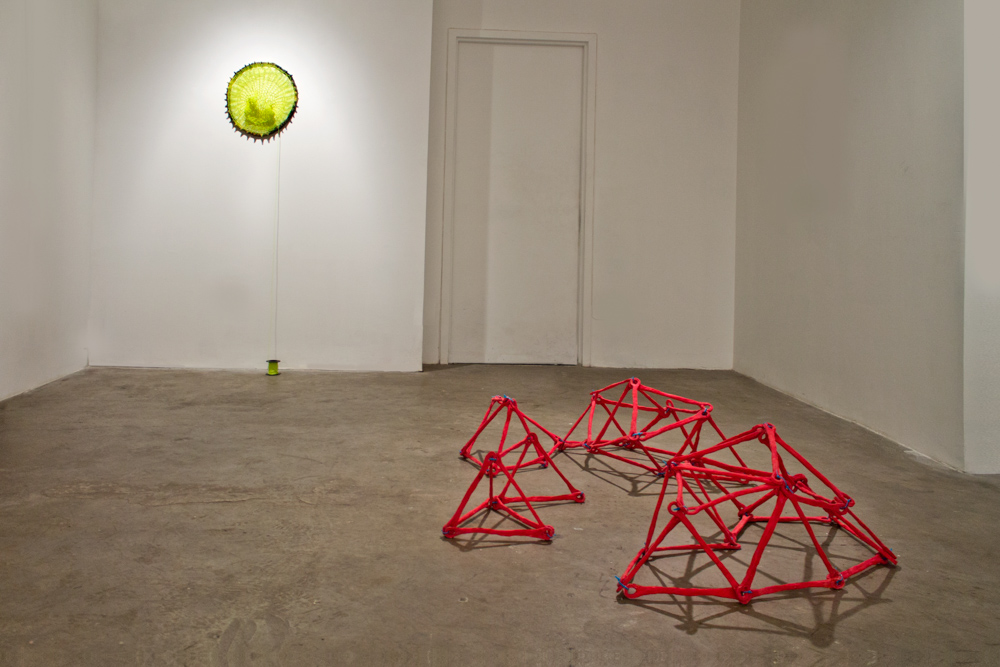
Loom Clock II and Modular Dome II, installation view
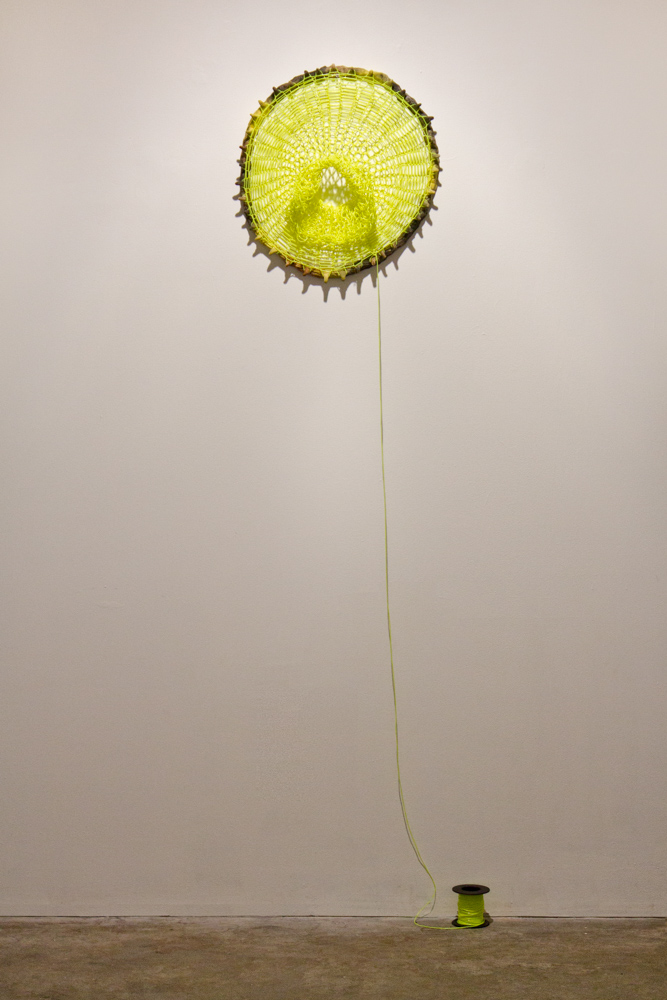
Loom Clock II, 2012, Clay and plastic, 2 x 18 x 18 in.
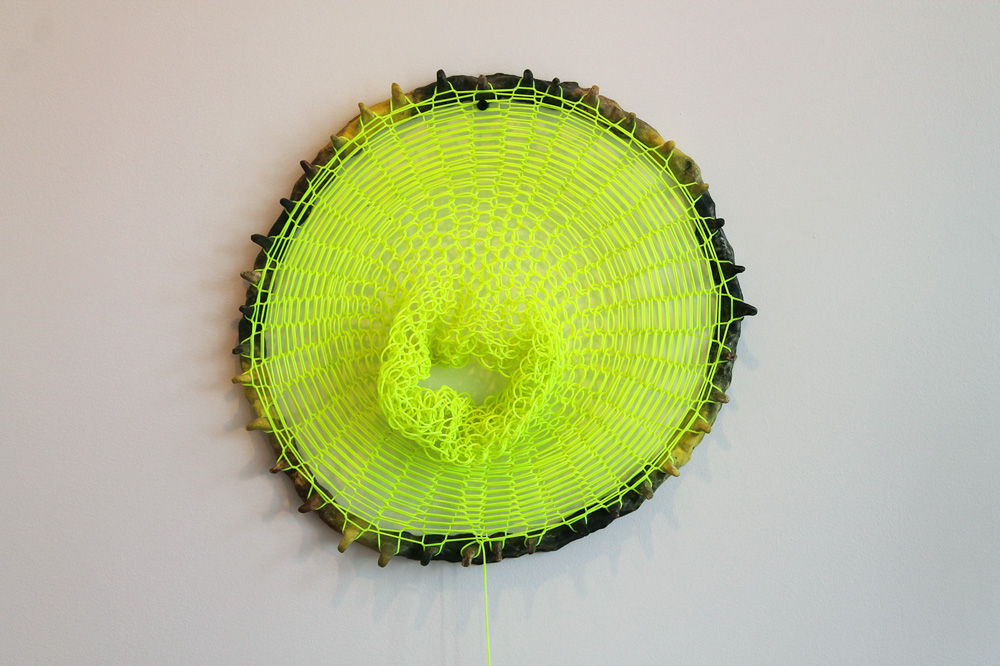
Loom Clock II, 2012, Clay and plastic, 2 x 18 x 18 in.
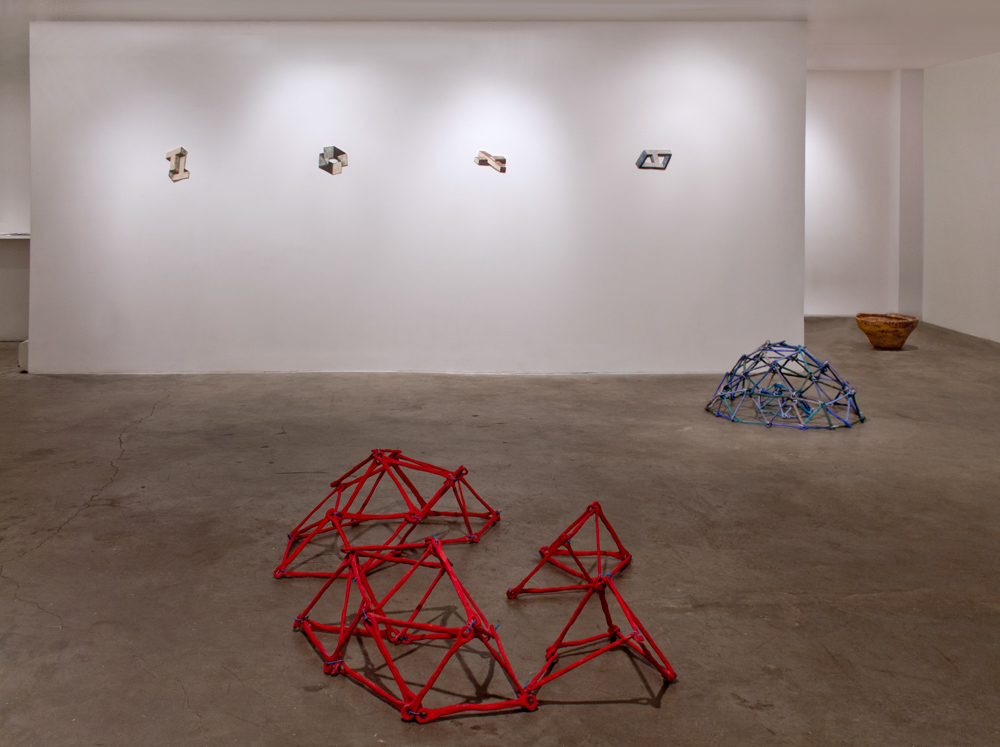
It's Been Hours, installation view, 2012, Scaramouche, New York

It's Been Hours, installation view, 2012, Scaramouche, New York
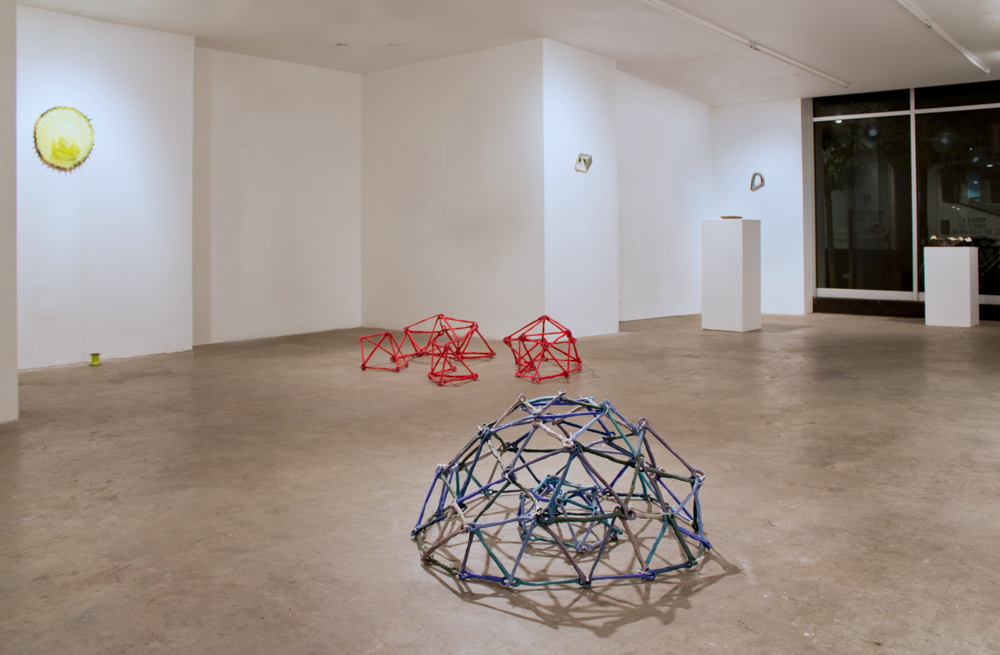
It's Been Hours, installation view, 2012, Scaramouche, New York
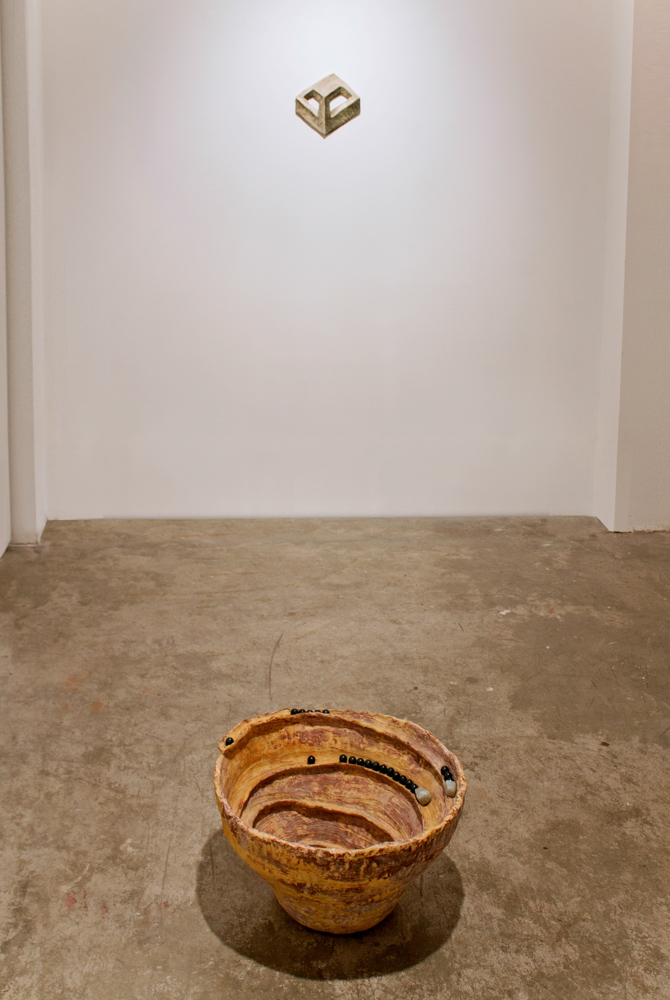
It's Been Hours, installation view, 2012, Scaramouche, New York
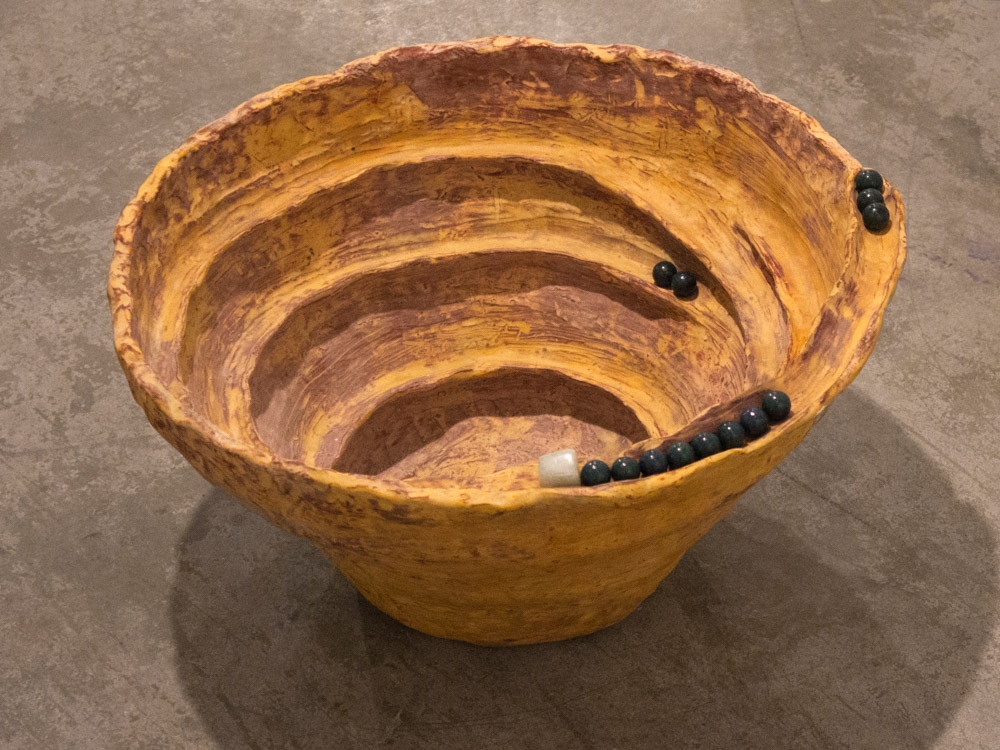
Round Ramp, 2012, Clay, glaze, glass marbles and soap stone, 11 x 18 x 18 in.

Round Ramp, 2012, Clay, glaze, glass marbles and soap stone, 11 x 18 x 18 in.

It's Been Hours, installation view, 2012, Scaramouche, New York

Evaporation Clock II, 2012, Clay, glaze and water mixed with pigment, 5 x 16 x 14 in.

Evaporation Clock, 2012, Clay, glaze and water mixed with pigment 1.5 x 9 x 9 in.
It's Been Hours (solo show), installation view, 2012, Scaramouche, New York
“From intuition one can pass to analysis, but not from analysis to intuition.” – Henri Bergson, An Introduction to Metaphysics
Scaramouche is pleased to present “It’s Been Hours,” the first New York solo exhibition of artist Leah Wolff. The exhibition, which includes pieces from two recent groups of sculptures, Clocks and Impossible Shapes, is meant to advocate for new alternatives to our currently singular method of investigation. Clocks promote an intuitive understanding of time, by measuring it according to the observer’s subjective experience. When looking at Wolff’s Impossible Shapes, our mind fluctuates between what we perceive and what we know to be true. The process and product of her practice explore the cognitive boundaries of our human experience.
Utilizing methods that are chiefly recognized as handmade, Wolff’s compositions are governed by the tension between their imprecision and the accuracy of a scientific model. In Modular Domes I, fired clay pieces are joined together in an arrangement reminiscent of a molecular structure. Her sculptures serve as demonstrative devices that encourage a better understanding of space and structure through the physicality of the object. In their finished form, they become an advocate for separate modes of personal discovery.
Positivism asserts that observational evidence is indispensable to forming our knowledge of the world, and that all things are ultimately measurable. In contrast, according to Heisenberg’s Uncertainty Principle, it is impossible to measure an electron’s position and momentum simultaneously. Electrons exist in a superposition, meaning that they partially occupy all of their theoretical states at the same time, so attempting to locate their exact position via observation suggests a fundamental misunderstanding of their quality. In this way, the modern scientific method has led us to a standstill.
The universe has been proven to be on the micro level immeasurable, and on the macro level far too vast to be knowable. Furthermore, it is only a small privileged class of scientists who have access to the approved technology needed to pursue these endeavors. Therefore, modern-day science becomes the institutional gatekeeper between us and the search for higher meaning, thus leading the individual to a space of intellectual disconnect from their surroundings.
This problem can similarly be applied to the understanding of time, which Henri Bergson discusses in Creative Evolution. Time’s measurement is at odds with its nature, which is always relative to the position and speed of the observer. Furthermore, measuring time (in seconds, minutes etc.) does a disservice to how we intuitively understand its duration, which is always relative to the consciousness that experiences it. In An Introduction to Metaphysics, Bergson distinguishes between two contrasting modes of knowing: relative and absolute. He promotes the absolute knowledge, defining it as an understanding gained only through experience.
In her wall reliefs, Wolff renders impossible shapes onto ceramic slabs. Although they are read as representations of 3-dimensional objects, upon further inspection one notes that it is not geometrically possible for such an object to exist in real life. This causes a fluctuation between intuition and logic: when looking at an Impossible Shape, our mind is forced to occupy the superposition of both states. Wolff posits that experiencing this mindset can lead the viewer to a higher understanding of what it means to occupy a superposition.
As Wolff continues to play with the fundamental elements of scientific theory by utilizing intuitive methods of problem solving, her practice functions as a new method of research where meaning is gathered through making.
Units of Measurement, 2012, Clay, glass cylinder filled with water, Dimensions vary
Modular Domes I, 2012, Clay, glaze and plastic, 17 x 38 x 38 in.
Modular Dome II, 2012, Clay, glaze and plastic, Dimensions vary
Loom Clock II and Modular Dome II, installation view
Loom Clock II, 2012, Clay and plastic, 2 x 18 x 18 in.
Loom Clock II, 2012, Clay and plastic, 2 x 18 x 18 in.
It's Been Hours, installation view, 2012, Scaramouche, New York
It's Been Hours, installation view, 2012, Scaramouche, New York
It's Been Hours, installation view, 2012, Scaramouche, New York
It's Been Hours, installation view, 2012, Scaramouche, New York
Round Ramp, 2012, Clay, glaze, glass marbles and soap stone, 11 x 18 x 18 in.
Round Ramp, 2012, Clay, glaze, glass marbles and soap stone, 11 x 18 x 18 in.
It's Been Hours, installation view, 2012, Scaramouche, New York
Evaporation Clock II, 2012, Clay, glaze and water mixed with pigment, 5 x 16 x 14 in.
Evaporation Clock, 2012, Clay, glaze and water mixed with pigment 1.5 x 9 x 9 in.















